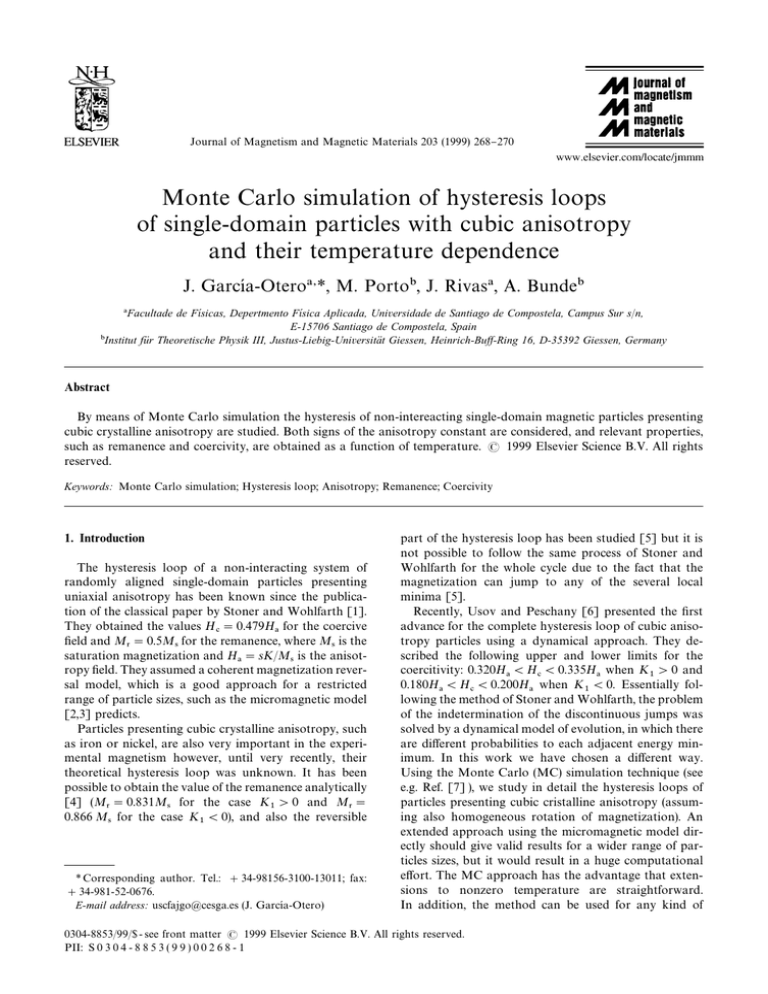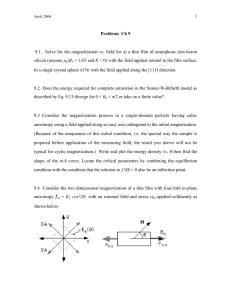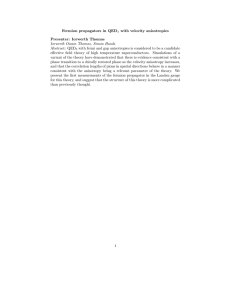
Journal of Magnetism and Magnetic Materials 203 (1999) 268}270
Monte Carlo simulation of hysteresis loops
of single-domain particles with cubic anisotropy
and their temperature dependence
J. GarcmH a-Otero *, M. Porto, J. Rivas , A. Bunde
Facultade de Fn& sicas, Depertmento Fn& sica Aplicada, Universidade de Santiago de Compostela, Campus Sur s/n,
E-15706 Santiago de Compostela, Spain
Institut fu( r Theoretische Physik III, Justus-Liebig-Universita( t Giessen, Heinrich-Buw-Ring 16, D-35392 Giessen, Germany
Abstract
By means of Monte Carlo simulation the hysteresis of non-intereacting single-domain magnetic particles presenting
cubic crystalline anisotropy are studied. Both signs of the anisotropy constant are considered, and relevant properties,
such as remanence and coercivity, are obtained as a function of temperature. 1999 Elsevier Science B.V. All rights
reserved.
Keywords: Monte Carlo simulation; Hysteresis loop; Anisotropy; Remanence; Coercivity
1. Introduction
The hysteresis loop of a non-interacting system of
randomly aligned single-domain particles presenting
uniaxial anisotropy has been known since the publication of the classical paper by Stoner and Wohlfarth [1].
They obtained the values H "0.479H for the coercive
"eld and M "0.5M for the remanence, where M is the
saturation magnetization and H "sK/M is the anisot
ropy "eld. They assumed a coherent magnetization reversal model, which is a good approach for a restricted
range of particle sizes, such as the micromagnetic model
[2,3] predicts.
Particles presenting cubic crystalline anisotropy, such
as iron or nickel, are also very important in the experimental magnetism however, until very recently, their
theoretical hysteresis loop was unknown. It has been
possible to obtain the value of the remanence analytically
[4] (M "0.831M for the case K '0 and M "
0.866 M for the case K (0), and also the reversible
* Corresponding author. Tel.: #34-98156-3100-13011; fax:
#34-981-52-0676.
E-mail address: uscfajgo@cesga.es (J. GarcmH a-Otero)
part of the hysteresis loop has been studied [5] but it is
not possible to follow the same process of Stoner and
Wohlfarth for the whole cycle due to the fact that the
magnetization can jump to any of the several local
minima [5].
Recently, Usov and Peschany [6] presented the "rst
advance for the complete hysteresis loop of cubic anisotropy particles using a dynamical approach. They described the following upper and lower limits for the
coercitivity: 0.320H (H (0.335H when K '0 and
0.180H (H (0.200H when K (0. Essentially fol
lowing the method of Stoner and Wohlfarth, the problem
of the indetermination of the discontinuous jumps was
solved by a dynamical model of evolution, in which there
are di!erent probabilities to each adjacent energy minimum. In this work we have chosen a di!erent way.
Using the Monte Carlo (MC) simulation technique (see
e.g. Ref. [7] ), we study in detail the hysteresis loops of
particles presenting cubic cristalline anisotropy (assuming also homogeneous rotation of magnetization). An
extended approach using the micromagnetic model directly should give valid results for a wider range of particles sizes, but it would result in a huge computational
e!ort. The MC approach has the advantage that extensions to nonzero temperature are straightforward.
In addition, the method can be used for any kind of
0304-8853/99/$ - see front matter 1999 Elsevier Science B.V. All rights reserved.
PII: S 0 3 0 4 - 8 8 5 3 ( 9 9 ) 0 0 2 6 8 - 1
J. Garcn& a-Otero et al. / Journal of Magnetism and Magnetic Materials 203 (1999) 268}270
distribution of particle orientations, and it allows the
study of interparticle interactions.
2. Model, numerical simulation, and results
Usually the cubic anisotropy energy is written as
E "K <(ab#ac#bc)#K <abc,
where (a, b, c) are the direction cosines of the magnetization with respect to the crystal directions and K and
K are the anisotropy constants, whose values are taken
from the experiments and are usually sensitive functions
of temperature. Since no interaction between particles is
considered, each particle is completely de"ned by a set of
six angles (h , ), (h , ), and (h, ). The "rst four angles
de"ning the orientation of the easy axes are kept constant
during the simulation of a single con"guration. The two
remaining angles which de"ne the magnetization direction will be variable throughout the MC simulation.
Taking into account both anisotropy and the interaction with an external "eld in z direction, the total energy
(with c"1!a!b and divided by 2"K "< in order to
compare the results with the Stoner}Wohlfarth model)
reads as
1
e "$ a#b!a!b!ab
2
K
# ab(1!a!b) !h cos h,
K
where h"H/H and H "2/K /M are as de"ned for
uniaxial particles. The plus sign corresponds to the case
when K is positive, the minus sign to the case when K is
negative. Furtheron, we restrict ourselves to the K "0
case only.
The MC algorithm is as follows: In every MC step an
attempted orientation l of the magnetization is gener
ated. The attempted direction is chosen in a spherical
segment around the present orientation l, which is used
as azimuthal axis, with M 3[0, 2p] and hM 3[0, dh]. Thus
the energy di!erence *e between the attempted and the
current state is calculated. If *e)0 the magnetization is
changed to k . If *e'0 the magnetization is changed
with probability exp(!*e/t) and remains unchanged
with probability 1!exp(!*e/t). Here, t"k ¹/
(2"K "<) is the reduced temperature. In any case the
variable counting the MC steps is increased and the
process is continued. Varying the aperture angle dh,
i.e. the maximal jump angle, it is possible to modify the
range of acceptance in order to optimize the simulation.
Using this kind of local dynamics allows us to detect the
con"nement in metastable states responsible for the hysteresis. Choosing a non-local algorithm and drawing the
attempted direction independently to the current one, the
system would always be superparamagnetic since it
would be possible to explore the whole phase space
269
independently of the temperature. To perform the complete hysteresis loop a very high "eld is applied initially at
very high temperature. Then the system is carefully thermalized to the desired temperature, and the loop is
started by slowly varying the reduced applied "eld in
steps of 0.05 (0.02 if h3[!0.5, 0.5] for better accuracy)
every 2000 MC steps. The process is repeated for a large
number of independent con"gurations to perform an
ensemble average.
The resulting reduced hysteresis loops for both K '0
and K (0 at ¹"0 are shown in Fig. 1. The loop for
uniaxial particles is also represented for comparison. For
K '0, the obtained reduced remanence M "M /M is
m "0.831$0.004, which is in perfect agreement with
the theoretical value [4]. The reduced coercive "eld is
h "0.316$0.002, which is within the lower limit of the
range given by Usov [6]. The reduced coercivity is lower
for K (0, than in the case with the positive constant,
the reduced remanence on the contrary is slightly
larger. The obtained value m "0.865$0.004 is again in
good agreement with the exact result [4], and h "
0.183$0.002 is within the limits given by Usov [6].
The evolution of the reduced hysteresis loops and
coercitivity with temperature for K '0 and K (0 are
shown in Figs. 2}4 respectively. As in the actual experiments the time of measurement plays an important role.
More time between changing "eld and measurement
means more time to relax. All the loops shown in the
present study are carried out with 2000 MC steps between measurements, this sets the blocking temperature
¹ when K '0 around k ¹ /(2K <)"0.02 in reduced
units. A comparison of simulations done with a di!erent
Fig. 1. Reduced hysteresis loops of non-interacting randomly
aligned single-domain particles. In the "gure the cases for uniaxial anisotropy (Stoner}Wohlfarth model) and for cubic anisotropy with both signs of the anisotropy constant are shown.
270
J. Garcn& a-Otero et al. / Journal of Magnetism and Magnetic Materials 203 (1999) 268}270
Fig. 2. E!ect of temperature on the hysteresis loops of noninteracting randomly aligned single-domain particles with cubic
anisotropy, case K '0. At high temperatures the loops become
superparamagnetic.
Fig. 4. Temperature dependence of the reduced coercivity for
both signs of the "rst constant of cubic anisotropy.
Thus, taking this additional dependence into account,
obtaining the measured parameters for a given material
is straightforward.
The simple model studied does not take into account
interparticle interactions, but can be of interest in the
case of very diluted systems of single-domain particles.
The in#uence of dipolar interactions will be our next
objective.
Acknowledgements
J. GarcmH a-Otero wishes to thank the autonomical
government of Galicia (Xunta de Galicia). M. Porto
acknowledges support from the Deutsche Forschungsgemeinschaft.
References
Fig. 3. E!ect of temperature on the hysteresis loops of noninteracting randomly aligned single-domain particles with cubic
anisotropy, case K (0. At high temperatures the loops become
superparamagnetic.
number of MC steps between measurements can be carried out by rescaling the temperature with the blocking
temperature. In whichever case, the functional dependence of the magnetic parameters will be the same, as will
be the shape of the loops.
Finally, it should be kept in mind that the parameters
which enter in the de"nition of the reduced magnitudes,
e.g., M and especially K , depend strongly on temper
ature, and consequently so does the anisotropy "eld H .
[1] E.C. Stoner, E.P. Wohlfarth, Philos. Trans. Roy. Soc. A 240
(1948) 599; reprinted by IEEE Trans. Mag. 27 (4) (1991)
3475.
[2] H. KronmuK ller, in: G.J. Long, F. Grandjean (Eds.), Superparamagnets, Hard Magnetic Materials, Kluwer Academic
Publishers, Amsterdam, 1991, pp. 461}498.
[3] A. Aharoni, Introduction to the Theory of Ferromagnetism,
Clarendon Press, Oxford, 1996.
[4] R. Gans, Ann. Phys. 15 (1932) 28.
[5] E.W. Lee, J.E.L. Bishop, Proc. Phys. Soc. 89 (1966) 661.
[6] N.A. Usov, S.E. Peschany, J. Magn. Magn. Mater. 174
(1997) 247.
[7] K. Binder, D.W. Heermann, Monte Carlo Simulations in
Statistical Physics, Springer Series inSolid State Science,
Vol. 80, second ed., Springer, Berlin, 1992.



